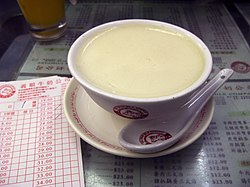| Part of a series on |
| Chinese cuisine |
|---|
 |
Chinese desserts are sweet foods and dishes that are served with tea, along with meals, [1] or at the end of meals in Chinese cuisine. The desserts encompass a wide variety of ingredients commonly used in East Asian cuisines such as powdered or whole glutinous rice, sweet bean pastes, and agar. Due to the many Chinese cultures and the long history of China, there are a great variety of desserts of many forms.










![Traditional Manchu sachima (below, two pieces) and rose cake (Xianhua bing [zh]) (upper left, split). Rose Cake, Sunni Efen white cake, and Sachima.jpg](http://upload.wikimedia.org/wikipedia/commons/thumb/6/6d/Rose_Cake%2C_Sunni_Efen_white_cake%2C_and_Sachima.jpg/250px-Rose_Cake%2C_Sunni_Efen_white_cake%2C_and_Sachima.jpg)




